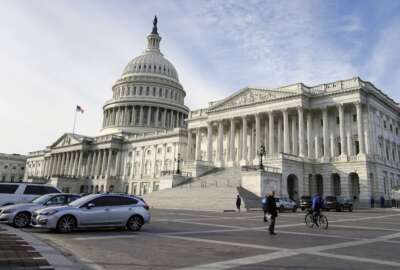Capitol Hill’s so-called budget is only the start of a lot of hard work
The top-line budget agreement Congress worked out last weekend doesn't mean the work is done. Members still have to work out the agency-by-agency allocations an...
The top-line budget agreement Congress worked out last weekend doesn’t mean the work is done. Members still have to work out the agency-by-agency allocations and whatever policy riders each side can stomach. For the industry view, The Federal Drive with Tom Temin spoke with the President and CEO of the Professional Services Council, David Berteau.
Interview Transcript:
Tom Temin And David, just when you think things are hopeless and we’re here for a shutdown or a rest of our lives CR well, something breaks. So, what’s the industry view of this?
David Berteau Well, Tom. Yes, the industry view is, uh, there’s a huge amount of uncertainty, right? This deal that was announced on Sunday and we’ve seen two sides of it. We’ve seen the statement from Speaker Johnson on the House Republican side, where he’s put out his letter to colleagues. And we’ve seen the statement from, Senate Majority Leader Schumer and, and House Minority Leader Jeffries, which casts a different light on the nature of the deal. But it is an essential first step, right? Because if you don’t have agreement on top line funding, you can’t do any of the other elements that come into play. So, contractors are at least glad to see some, uh, agreement on what the numbers look like. So, we can go into those numbers a little bit and then into the next steps.
Tom Temin But that final top line number that they did agree to is derived at some loose degree from what it is that the administration submitted for a 2024 budget. So, it’s not as if HHS is going to get a $50 billion variance or anything.
David Berteau No, that’s probably true. And, uh, and within it. So, you know, the original Fiscal Responsibility Act, which was passed late May and the president signed on June the 3rd, that’s the one it didn’t avoid a shutdown. What it avoided was default on national debt. Right. Which is far more traumatic to the global economy than a government shutdown would be. Um, that had a cap of 886 billion for defense, 704 billion for civilian agencies. But then there were these side deals to add, about another 69 billion to the civilian agencies that would get them back up to not really what the president had requested, but well above, uh, what they had for FY 23. The real problem, though, as you alluded to, is how do you break this down, agency by agency. The Fiscal Responsibility Act didn’t do that. Each House of Congress, uh, did their own from, uh, from an appropriations point of view, but it didn’t include all of the side deals. And now they’ve got to go back and rework these, especially on the House side, and they don’t have much time. I mean, Tom, you know, between the 9th of January, uh, today and the 19th of January, when, uh, the first four bills come due or we have a shutdown, um, that’s only a handful of legislative days, and there’s an awful lot of work to be done. So, this is this is where contractors have to be paying close attention.
Tom Temin All right. So, you have outlined a possible path forward. If Congress would listen to David Berteau and others that have a rational view of the way things ought to work in the world. And let’s go through some of those.
David Berteau Your show gives us the opportunity for at least somebody to hear us, whether they listen or not, remains to be seen. But you’re right. There are really four possible paths forward. I mean, the easiest one of the one that is most consistent with what regular order would be is the appropriators will rewrite all 12 bills, or at least the four that are due on January 19th, and they’ll pass Congress, and they would be signed by the president before we get to that shutdown deadline. This is really hard. Uh, not only is it hard to do from a legislative point of view, but on the House side, you know, the House, Freedom Caucus has already indicated they’re going to be opposed to this. They run the Rules Committee. You cannot get a rule through without Democratic votes. Uh, so you either have to be under suspension of the rules, or Democrats will have to vote for the rule, in the committee. And of course, then there’s always the possibility of that single member proposing a motion to vacate the speakership. Uh, which we’ve run into. So, there’s some sort of bureaucratic hurdles, legislative bureaucratic hurdles along the way here. But that’s one path forward. You could actually implement the deal through full year appropriations. The second path forward is you could, in fact, make enough progress that you’d say, okay, now we know what the deal looks like. Let’s you do a full year continuing resolution, which is almost like a full year appropriation. It would just be one bill instead of 12 separate bills.
Tom Temin Yeah, that’s a good point. We’re speaking with David Berteau, president and CEO of the Professional Services Council. This does not. The deal that is does not rule out a CR for the rest of the year.
David Berteau It does not. And you know, the speaker, Speaker Johnson has stated publicly that that he does not intend to bring a short-term CR to the House floor for a vote. He did not say he would not bring a full year CR to the House floor for a vote. So that is a second path forward. The third path forward, of course, would be a short-term CR that would just buy you time to continue implementing the deal. Of course, when the speaker says he’s not going to bring such a bill to the floor for a vote, which makes it a little hard for that option to occur. It could be done under a discharge petition. There is a right discharge petition that could be activated for this, although it will still take about seven legislative days. So, it had to be activated really soon. And. Of course, the fourth path forward, and perhaps the most likely, given the time constraints here, is we will have a partial government shutdown at midnight on January 19th. Um, and there are some real implications for that. It’s not only the four agencies covered by the appropriations bills, but there are three other cabinet departments, part of which would shut down and part of which would remain open, a very complicated procedure for the government to operate in.
Tom Temin Yeah. Imagine what that would do to telework policy if some of the people aren’t working at all.
David Berteau Yeah. No. No kidding. So, within DoD you have all the military construction and family housing, and real property maintenance would be suspended, but the rest of DoD would keep operating in HHS you would have the Food and Drug Administration suspended because that’s under the agriculture appropriations bills. But the rest of Health and Human Services would continue to operate. And under Energy, all of energy would shut down except for the part of energy on the nuclear side, the NNSA side, which would remain open and continue to operate. No guidance, as far as we know, has been issued either by these agencies or from OMB as to how they’re going to do that. So that’s one of the important things that contractors need to look at. There are a couple of others.
Tom Temin Well, just on that point alone, the uncertainty that contractors feel then would be derived from the uncertainty that agency buyers must feel because they don’t know when or how much money they’re going to get. And so that tends to make them very conservative on commitments.
David Berteau You are absolutely right, Tom. Every agency, every program doesn’t know a. Are we going to keep going or not. b. At what funding level and c. When. Right. And so the natural tendency as you indicate is if I don’t know what’s going to happen, if I don’t know how much money I’m going to have, if I don’t know when I’m going to get it, I’m not going to do very much right now because I want to wait and see what comes on. So, the very first thing contractors have to do is be communicating very carefully with their government customers on what those expectations are. Possibilities are. The second thing that contractors have to do is they really got to prepare for all four of those path forward that I have, uh, laid out there, because you might get money, you might get it soon, you might get it later, you might not get it at all. You might have a shutdown. And we’ll have to see how this plays out. I haven’t even mentioned the further complicating, uh, dynamic here, which is the debate over the supplemental for Ukraine and Israel and Taiwan and the border, uh, which is hanging in the balance as well, and has some very real near-term implications, both for the government agencies and for contractors themselves.
Tom Temin Yes, because in that supplemental is a lot of military spending.
David Berteau A lot of military spending, and much of it is to replenish the supplies and the stockpiles of munitions and weapons systems that have been drawn down from those stockpiles over time. Um, both for Ukraine and in recent months, for Israel itself. And by the way, the Taiwan election results loom large here as well, because we’re going to see what the Chinese reaction is, uh, to the results of yesterday’s elections when we get the final poll. Poll numbers aren’t.
Tom Temin Sure, but what we need then are more shell companies to be created. That is, howitzer shell companies.
David Berteau Uh, well, uh, we a little-known fact that we actually reduced, uh, the capacity that we had to produce these munitions, particularly 155-millimeter shells, as part of the base closures back in 2005. Because, of course, at that point, we didn’t see what was coming and what we see now in 2024. It just goes to show that the government needs to rely on its contractors to be able to shift and surge when necessary. But the government’s responsibility for creating both the requirements for that surge and the funding capacity for it. We’ll see more of that later this week. DoD is going to release its first ever, industrial base strategy. We’re looking forward to seeing what that is, and we’ll be happy to talk with you further about that on a later show.
Copyright © 2024 Federal News Network. All rights reserved. This website is not intended for users located within the European Economic Area.
Tom Temin is host of the Federal Drive and has been providing insight on federal technology and management issues for more than 30 years.
Follow @tteminWFED






